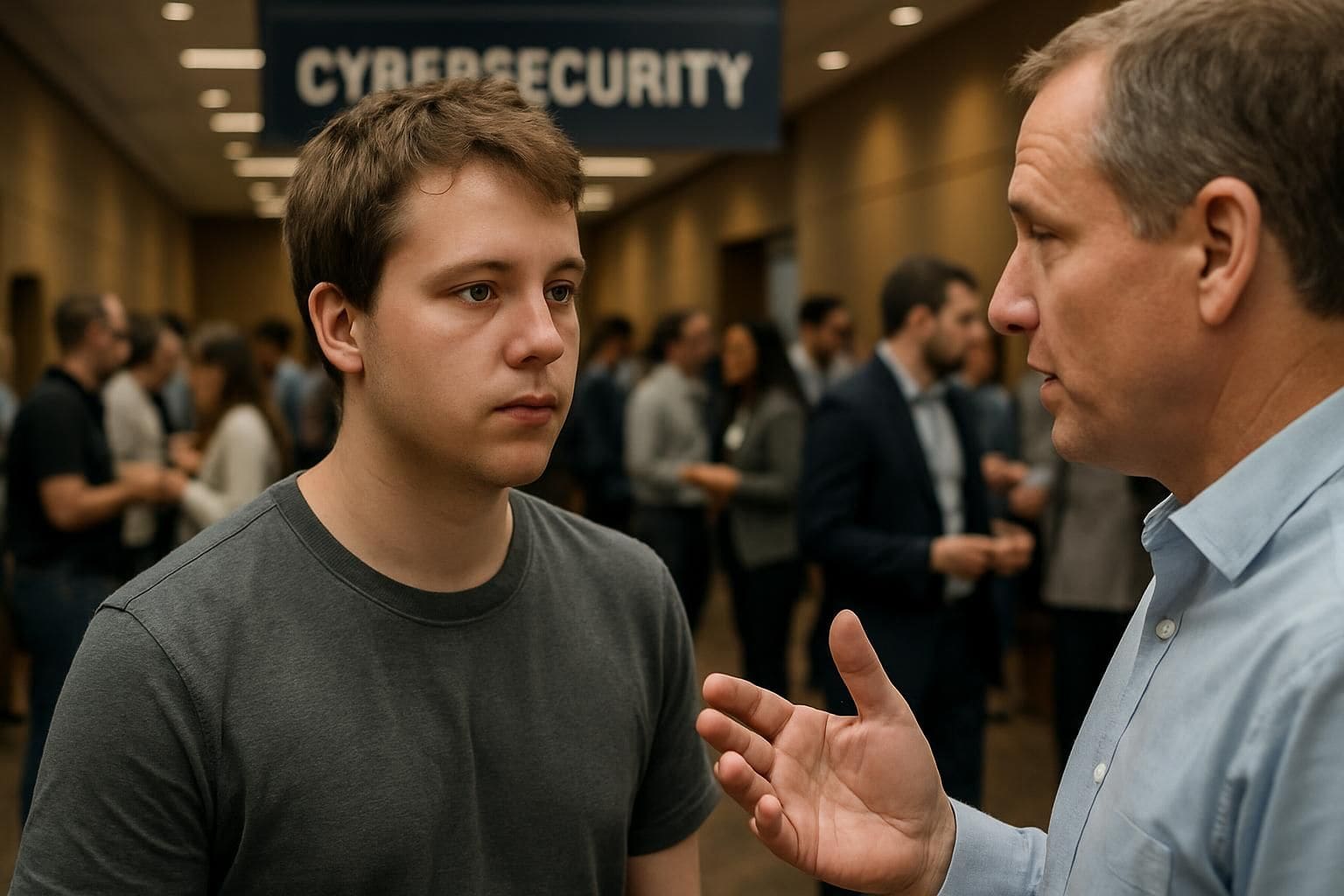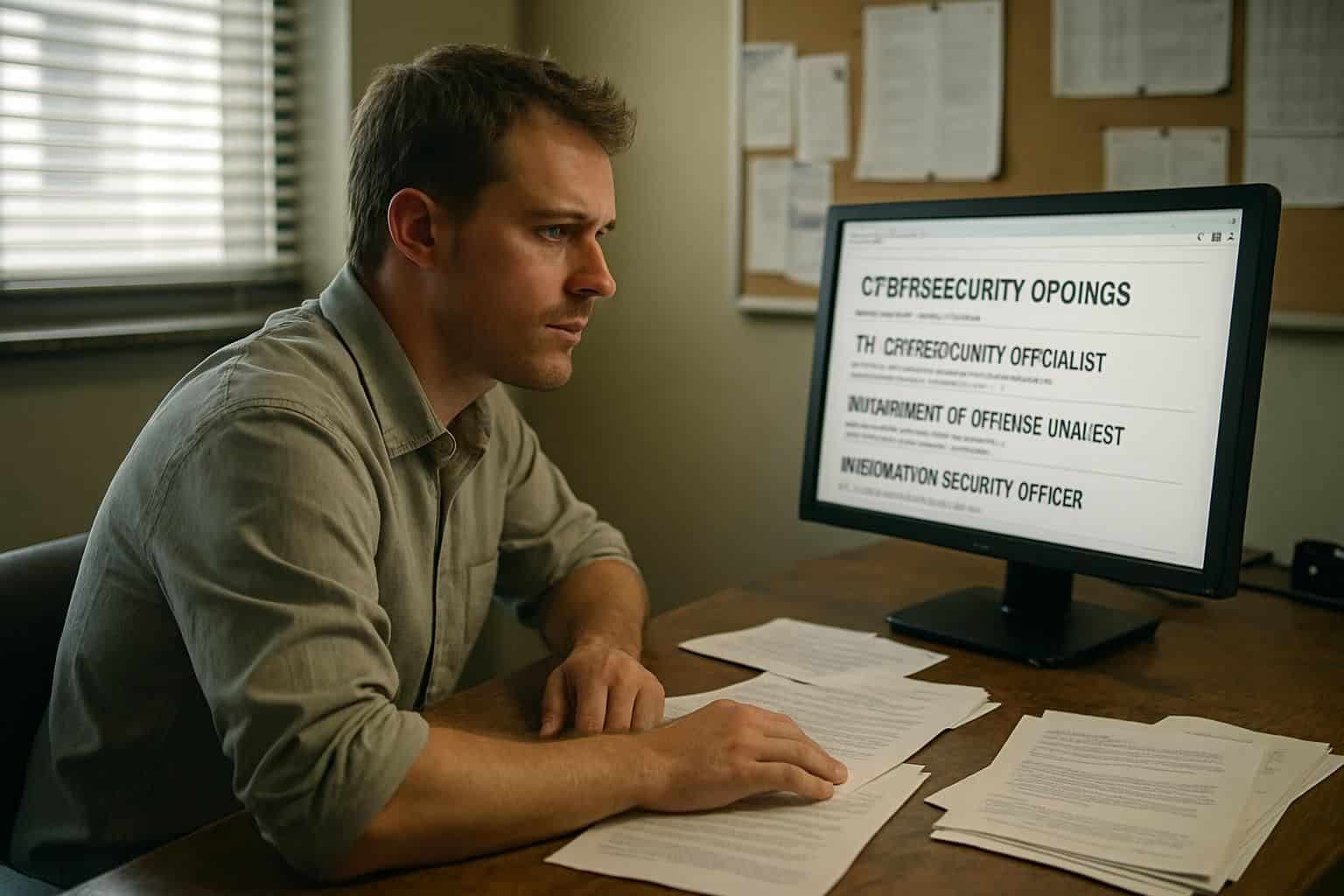You’re ready to find a new career, but not sure how to get a job in cybersecurity. The demand for cybersecurity professionals is set to grow by 33% over the next 10 years, according to the Bureau of Labor Statistics.
This guide gives you clear steps like education paths, key certifications such as CompTIA Security++, and tips on landing entry-level roles in cybersecurity. Start your path today with these 14 simple steps.
Key Takeaways
Cybersecurity roles will jump 33% over the coming decade—with 3.5 million positions still unfilled globally as of 2021.
You can jump in without a college degree—bootcamps or self-study work great—but the CompTIA Security+ cert ($392) is a helpful starting point.
Entry-level positions, like SOC Analyst, easily grow into senior jobs—and salaries can go from about $60,000 to well past $150,000.
Employers often value practical experience—through home labs, internships, or volunteering—even more than formal degrees.
Joining groups like ISACA or events such as Black Hat lets you meet professionals and hear about jobs even before they’re posted.
Table of Contents
Understanding the Cybersecurity Job Landscape

Cybersecurity jobs have grown 35% in the last five years, with roles ranging from entry-level analysts to senior architects. You can start in IT support and move up to specialized roles like penetration tester or security architect – with salaries jumping from $60,000 to over $150,000 as you gain skills.
Growth in cybersecurity roles
Right now, the job market for cybersecurity specialists is red-hot. Companies need way more security experts today than ever—job posts jumped by 68% since 2010. In fact, this field is growing 12 times quicker than the average job market in the U.S. Demand just keeps climbing, as hackers continue targeting businesses big and small.
The skills gap gets wider each day.
Experts estimate 3.5 million cybersecurity roles worldwide stayed empty in 2021. For men thinking about a new career, this shortage makes now a smart time to get started. Between 2023 and 2033, Information Security Analyst jobs in particular will rise by 33%.
That growth beats almost every other occupation out there. Companies have trouble filling these roles with skilled talent to keep their networks and data safe. Sure, using a free VPN might be enough for personal browsing—but businesses require real, trained security pros.
Common cybersecurity career paths
Cybersecurity gives you clear career paths to grow into. Most people start as analysts in a Security Operations Center (SOC). From there, you might become a senior analyst, join an incident response team, or move into security software development.
Some folks even specialize in computer forensics. At the top, you’ll find positions like Chief Privacy Officer (CPO) and Chief Information Security Officer (CISO)—roles that let you lead entire teams.
The best security professionals follow their interests and build expertise in specific areas they enjoy.
Broadly speaking, cybersecurity has four main career tracks. There’s Engineering and Architecture—building secure systems. Incident Response means handling breaches as they happen.
Management and Administration involves policy setup and team leadership. And Testing is all about discovering vulnerabilities and weak points. Each area calls for certain skills, but they all rely on technical knowledge and smart problem-solving.
IT support staff often shift into security after picking up foundational tech skills. Earning certifications like Security+ or Certified Ethical Hacker (CEH) opens doors to more specialized jobs that fit your talents.
Education Needed for Cybersecurity Jobs

You don’t need a fancy degree to start in cybersecurity. Many pros enter the field through college programs, but others learn through online courses or teach themselves key skills.
Traditional degrees
A bachelor’s degree in Cyber Security, Computer Science, or IT sets the foundation for most cybersecurity roles. These four-year programs build core skills—network security, coding, and understanding risks—skills employers truly want.
Many colleges now offer specialized cybersecurity tracks, focused on tackling real threats and defense strategies.
For advanced career moves, a master’s degree covers deeper areas, like spotting cyber threats and designing security systems. A Ph.D. boosts earning potential by about $10,000 to $20,000 each year over those without doctorates.
Big universities and online schools offer flexible classes, easily fitting courses into busy schedules—perfect for people switching into cybersecurity careers later on.
Bootcamps and self-guided learning
Cybersecurity bootcamps offer tons of knowledge in short periods—anywhere from five days to six months. They focus on key certifications like CompTIA Security++, giving you practical skills quickly for a career change.
Plenty of guys like bootcamps for this exact reason—fast, practical training. Free platforms such as Cybrary.it and Khan Academy also help you get started without spending money.
If money’s tight, Udemy has cybersecurity courses for less than $20. Or, you can try structured courses from platforms like edX.org that let you set your own pace. These courses blend theory with real hands-on exercises.
You’ll build solid technical skills to qualify for entry-level cybersecurity jobs. Next up, we’ll cover the skills you need to score one of the coolest jobs for men in tech.
The best investment you can make is in yourself through continuous learning.
Essential Skills for Cybersecurity Professionals

You need both hard and soft skills to excel in cybersecurity. Technical know-how in areas like network security and coding must pair with strong problem-solving and clear communication.
Technical skills
Solid tech skills are key for any cybersecurity role. Get familiar with network security basics—including operating systems like Windows and Linux—and security tools. Knowing at least one coding language like Python helps create quick scripts to test systems.
Understanding common security frameworks—NIST and ISO, for instance—is often required. Also, knowing compliance rules, like GDPR and HIPAA, helps you stand out.
Experience in penetration testing lets you find weak points early—before hackers can. Cloud security becomes more valuable every day, as businesses store more data online. Being good at risk management lets you spot issues quickly and respond right away.
The best security experts stay updated, continuously picking up new skills as threats shift. Most employers look closely at your practical experience with virtual machines and security tools—not just your degrees or certifications.
Soft skills
Technical know-how is just part of your cybersecurity skillset—soft skills matter equally to hiring managers. Clear communication lets you break down tricky threats for people who don’t know tech-speak.
You translate complicated security issues into everyday language that bosses and clients quickly grasp.
Good problem-solving helps you succeed in cybersecurity roles. Every day brings new threats, calling for smart thinking and quick responses. Your team values calm minds who confidently handle pressure and rapidly fix issues.
Other important soft skills include careful attention to small signs of unusual network activity, teamwork when handling incidents, and strong ethical judgment around private data.
Such human skills set apart great security experts from ordinary ones.
The best security professionals combine technical expertise with exceptional communication skills to protect organizations effectively.
Certifications to Boost Your Cybersecurity Career

Cybersecurity certifications give your resume a major boost in the job market. Getting certified proves your skills to employers and can help you earn a higher salary right away.
CompTIA Security+
CompTIA Security+ is the leading entry-level security certification in the U.S., with over 265,992 certified professionals. It’s proof you understand key areas like risk assessment, incident response, and security controls.
The test costs $392, lasts 90 minutes, and includes up to 90 questions. Many IT support staff get this cert first—it’s a good starting point before moving up to more advanced security roles.
Big companies, like Walmart, really value Security+ since it means you can identify and stop cyber threats. After Security+, the usual next step is earning advanced certifications, such as Certified Ethical Hacker (CEH).
Certified Ethical Hacker (CEH)
The Certified Ethical Hacker (CEH) shows you can think like a hacker—but for the good side. It’s a top security certification, costing roughly between $1,699 and $3,499. On average, CEH-certified pros earn about $100,008 a year, making it a valuable career choice.
The exam checks your ability to spot system weaknesses and patch them quickly—before real attackers get in.
In your training, you’ll handle the same tools used by cyber criminals—but in a safe, defensive way. You’ll practice things like network scanning, creating test viruses, and breaking into systems through interactive lab activities.
Both government roles and private companies often prefer applicants with CEH on their resumes. This certification also trains you to notice minor security flaws in IT systems that others easily overlook.
Certified Information Systems Security Professional (CISSP)
CISSP is a top-level security certification for IT pros ready to advance. It proves you have strong skills in protecting data and systems. CISSP-certified experts earn around $124,000 each year—that makes it one of cybersecurity’s highest-paid roles.
The exam covers risk assessment and spotting threats early—before they cause damage. Companies often seek CISSP holders for senior security jobs. Roles like Security Analyst, CISO, and eight other high-demand jobs become open to you with this cert.
The test can be tough—but it pays off big-time in career growth. Hands-on practice with real security tools makes passing easier. It also helps you apply your new skills directly on the job.
Next, GIAC Security Certifications can also help boost your career.
GIAC Security Certifications
After CISSP, GIAC Security Certifications offer another great step for proving your cybersecurity skills. These certifications come in three clear types—Practitioner, Applied Knowledge, and Portfolio.
Big companies from various industries often look for GIAC certs in job candidates. What’s really great is, 92% of people with GIAC certs say they feel more confident about their cybersecurity abilities.
GIAC certifications gave me the edge I needed in the job market. They test real-world skills, not just book knowledge. – Mark Chen, Security Architect
GIAC tests assess practical skills you actually use in cybersecurity jobs—not just theory or textbook concepts. They make sure you’re ready to handle real-world threats right away.
Since GIAC comes from the respected SANS Institute, hiring managers give these certs extra attention. Jobs in penetration testing, reverse engineering, or incident response often prefer applicants with GIAC credentials.
Federal agencies and government contractors frequently require these certifications on job applications too.
Gaining Practical Experience

Hands-on practice through internships, labs, and volunteer work builds the real-world skills that hiring managers want to see — start building your cyber resume today!
Internships
Cybersecurity internships give you real, practical experience, something textbooks or classes alone can’t offer. You get to solve actual security problems, guided by professionals doing these tasks every day.
Top companies like Cisco, IBM, and even the FBI offer internships lasting between three to six months, where you’ll get practical training using tools like Wireshark and Kali Linux.
Plus, your internship manager could become your first professional reference—or even hire you directly.
Connecting with industry experts during your internship quickly grows your professional network. You’ll meet teammates, fellow interns, and industry professionals who could assist you down the road.
Some internship positions even provide free certification training—like Security+ or CEH—which normally cost hundreds of dollars. Volunteering is another great way to boost your cybersecurity skills and experience.
Hands-on labs and simulations
Virtual machines are great for sharpening your cybersecurity skills. Try VirtualBox or VMware to build a home lab—it’s safe, private, and perfect for practice. Set up your own network, install various operating systems, or test out security tools without worrying about harming real computers.
A lot of security pros got their start exactly this way.
You can also try online platforms—like TryHackMe or Hack The Box—for ready-to-go security challenges. They offer Capture The Flag (CTF) games, where you solve security puzzles and practice breaking into simulated systems.
Completing these exercises develops practical skills employers want to see in job interviews. Showing these hands-on experiences on your resume makes you stand apart from others—proving you have more than theoretical knowledge.
Volunteer work in cybersecurity
Free cybersecurity work can lead directly to paid jobs. Non-profits, schools, and community groups often need tech help—but usually lack the funds. You can step up, solve real problems, and boost your skills at the same time.
Even GitHub projects or hackathons count as volunteer experience, letting you display your coding know-how to future employers.
In fact, plenty of security experts got their start by volunteering. By doing real-world tasks—not just class assignments—you prove your ability to handle actual security threats.
Plus, it’s a casual way to connect and network with cybersecurity professionals, folks who often know about job openings—even before they’re made public. Building these contacts makes landing your first paid cybersecurity job much easier and faster than going it alone as a digital nomad.
Networking in the Cybersecurity Industry

Joining groups like CompTIA or attending security conferences puts you in touch with hiring managers and mentors. You can meet people at events or through online forums who might help you land your next job.
Joining professional organizations
Professional groups like ISACA and (ISC)² seriously boost your chances in the cybersecurity job market. Just having these memberships on your resume shows employers you’re committed and involved.
Plus, these organizations often provide exclusive job boards—posting openings well before they’re listed publicly. They even offer specialized training and resources, keeping your skills updated in this rapidly changing field.
Other groups, like CompTIA and SANS, can help you make valuable industry connections. Through meetups and online communities, you’ll get to chat with professionals—people who often know about hidden job opportunities.
Some of these folks might turn into career mentors who help guide your next moves. Building your network through these groups can land you more interviews—and better positions—than applying cold online.
Your next step is crafting the right resume, one that grabs attention in the cybersecurity job market.
Attending industry events and conferences
Going beyond just joining industry groups—you need to show up at events too. Cybersecurity conferences like Black Hat, DEF CON, and RSA put you face-to-face with industry pros. It’s a great chance to meet skilled experts who can point you in the right direction.
At these meet-ups, you’ll hear useful tips from talks and workshops. Most events have keynote speeches from tech security leaders, plus panels covering today’s hottest security threats.
Lots of conferences even host job fairs—employers come ready to recruit new hires. So dress smart, carry some business cards, and you’re set to impress. The connections you build at these events sometimes lead to job offers and tips that don’t make it onto regular hiring sites.
How to Build a Strong Cybersecurity Resume

Your resume must show off your cyber skills and real-world work. Make it stand out with proof of your CompTIA Security+ cert and hands-on projects from GIAC training courses.
Highlighting skills and certifications
A solid cybersecurity resume highlights technical skills clearly and quickly. Showcase key abilities, like intrusion detection or network security, that line up with the job listing.
Numbers grab attention—mention how you reduced security risks by 30%, or saved your past employer $50,000 a year. Certifications belong in their own clear section, along with the dates completed.
Credentials like CompTIA Security+, CEH, or CISSP impress recruiters fast. If you’re applying for government roles, mention current security clearances you have. Cloud skills are especially valuable lately—mention experience with AWS, Azure, or Google Cloud.
Link every skill you list to actual successes, rather than job duties alone.
Demonstrating practical experience
Your resume should do more than list skills or certifications—it needs examples of what you’ve done. Employers care about seeing proof, real proof, that you can handle cyber threats.
Show this clearly with stats, things like “cut security incidents by 30%” or “patched 15 critical vulnerabilities”.
You can also build a portfolio to share your practical skills. Include screenshots from your home lab, write-ups of CTF events you’ve completed, or GitHub projects highlighting your coding.
Even volunteer experience matters—like helping a local nonprofit secure its network. That’s valuable real-life experience you’ll talk about in job interviews.
Lots of cybersecurity specialists start out doing IT support or working a help desk. These roles give you a clear understanding of systems you’ll protect later on.
Finding Entry-Level Cybersecurity Jobs

Finding entry-level cybersecurity jobs takes less effort than you might think. Job boards like Indeed and LinkedIn list many IT support and help desk roles that can start your security career.
Job boards and online platforms
Specialized job boards make landing cybersecurity roles easier. Sites like CyberSecJobs.com and SecurityClearanceJobs.com match postings to your skills and clearance level. USAJOBS serves as the primary portal for federal roles—great for info security analyst positions.
Plus, you can filter listings by your experience, which means finding entry-level jobs gets simpler.
CyberSeek’s Career Pathway tool helps you visualize cybersecurity career options. This free resource outlines skills you’ll need—from IT support roles up through pen testing positions.
Many job sites offer email notifications, keeping you updated on new openings based on your profile. Set up daily alerts on LinkedIn, Indeed, and Dice—this ensures you stay connected to fresh cybersecurity opportunities suited to your skills and background.
Cybersecurity roles open to beginners
Many cybersecurity jobs welcome beginners with basic skills—so it’s not hard to get started. For example, Information Security Analysts earn about $77,000 per year and mostly keep an eye on networks for threats.
The role requires decent problem-solving skills and some basic security knowledge. IT Support specialists often shift into cybersecurity roles after building their technical experience.
Jobs in help desks teach customer support, plus give you a good feel for common security problems.
Junior Penetration Testers, or “pen testers”, earn around $80,000 annually and test systems for weak points. These roles require ethical hacking skills and usually the CEH certification.
IT Auditors review company security practices to see if they follow rules and standards. Federal groups like the Environmental Protection Agency often hire cybersecurity workers with limited experience—but they do need background checks.
The Cybersecurity and Infrastructure Security Agency has programs specifically for recent grads. Holding a CompTIA Security+ certification helps a lot in landing these positions.
Cybersecurity Job Opportunities in the Government

The federal government offers some of the most stable and rewarding cybersecurity jobs in the market. You can find roles with agencies like the FBI, Department of Defense, or the Indian Health Service that provide great benefits and clear paths for growth.
Federal hiring paths
Federal jobs provide clear hiring options for veterans, military spouses, and individuals with disabilities. On USAJOBS, you’ll find lots of cybersecurity roles offering these special paths.
I spent five years as a federal IT specialist—and saw up close how these hiring channels quickly connect skilled people with jobs. Just be sure to confirm which program matches your personal situation ahead of time.
Pay and benefits in government work are really attractive. Health, dental, vision, and life insurance kick in from your very first day. Plenty of entry-level jobs won’t ask for a security clearance right away—but as you move up, some higher-level roles will require one.
Cybersecurity pros in the GS-13 through GS-15 pay range earn some of the best salaries around, especially if they bring solid skills and a strong background.
Security clearance requirements
Getting a security clearance can lead to high-paying cybersecurity jobs within the U.S. government. Basically, America has three clearance levels—Confidential, Secret, and Top Secret—with each granting access to different kinds of classified info.
The clearance process involves three main steps: application, investigation, and adjudication (just a fancy word for approval). They’ll check your background carefully for anything suspicious or risky.
Five key things can block your clearance: not having U.S. citizenship, a dishonorable military discharge, serious criminal records, drug involvement, or lying during your application.
The investigators look closely at your finances, travel history, and personal contacts. This whole process usually lasts around 3-6 months for lower-level clearances—and maybe up to a full year for Top Secret.
So, try to start early if you’re aiming for a position needing a clearance.
Exploring Remote Cybersecurity Jobs

Remote cybersecurity jobs have grown fast since 2020, with many firms now hiring work-from-home security pros. You can find these roles on sites like LinkedIn and Indeed, or through cyber job boards that list cloud security, SOC analyst, and pen tester positions.
Popular remote roles
IT Technicians solve computer problems from home and keep systems up and running smoothly. Many businesses now hire Security Engineers remotely, paying salaries up to $150,318 per year, to build solid online defenses.
Cybersecurity Sales Specialists can work fully from home too—helping customers find effective security tools without ever leaving their couch. These positions let you battle cyber threats while skipping traffic jams and morning drives.
Demand for remote info security jobs keeps rising, as more firms shift their systems onto cloud platforms that workers can manage from any place.
Benefits of remote work in cybersecurity
Cybersecurity roles from home offer major perks beyond typical remote jobs—like flexible hours and working wherever suits you. Many folks focus better without office chatter and interruptions, producing higher-quality results.
Companies benefit too, hiring top talent from any state, not just local hires. Plus, cybersecurity skills are in serious demand, keeping job security high—even remotely. Working remotely can also mean tax breaks for your home office setup.
Skip pricey commutes and wasted travel time, and craft your perfect workspace instead. Many remote pros even say they achieve healthier work-life balance—a big plus for staying stress-free in cybersecurity.
Tips for Standing Out in Job Applications

You need to make your job application shine in a crowded field. Smart job seekers tweak each resume for the exact job and prep hard for tech tests.
Tailoring your resume and cover letter
Tailor your resume for every job posting… yes, every single one. Adjust your skills section to match exactly what they’re asking for. If the company highlights risk management—put your risk-related experience front and center.
Use the same wording as in the job posting itself—help them see you’re an exact match.
For cybersecurity roles, clearly list certifications like CompTIA Security+ or CEH. Make sure they’re easy to spot.
And the cover letter? Write a quick story showing your real passion for cybersecurity. A genuine, personal reason you care about stopping cyber-attacks goes a long way. Hiring managers often skip generic applications—yours has to feel real.
A targeted resume sent to one company usually beats a generic resume sent to 50 places. Drop skills that aren’t relevant to the role. Always include specific numbers from past roles—like “protected company networks with 99.9% uptime” rather than just “skilled in network security”.
Preparing for technical interviews
Cybersecurity job interviews test your skills—and your problem-solving style. Platforms like CodeBashing and LeetCode help you practice coding beforehand. Also, read up on common security threats and ways to protect systems.
This shows interviewers you’ve got what it takes for real-world work. Mock interviews with friends let you practice talking clearly about tricky topics.
Match your resume closely to each job listing. Check what skills employers highlight, and prep for those first. Gather examples from past jobs or class projects where you tackled security issues.
Some companies give practical tests—you spot and fix security flaws right then and there—so practice this often. Solid prep boosts confidence and shows employers you’re ready to handle cybersecurity duties.
Future Trends in Cybersecurity Careers

Cybersecurity jobs will change fast as AI and machine learning grow. New roles in cloud security and IoT defense will pay more as companies fight harder for skilled pros.
Emerging job roles
Right now, AI and blockchain are creating new jobs in cybersecurity. Roles like AI Security Specialists and Blockchain Security Experts need people ready to outsmart advanced hackers.
Cloud Security Architects protect information stored online. IoT Security Pros keep smart devices in homes and cities safe. Threat Hunters track potential hackers before attacks happen.
Today, around 10.2 million cybersecurity jobs remain open worldwide. Workers with the right skills can choose from many roles, enjoy solid pay, and often work remotely.
This job market expands quickly, as risks grow each day. Risk Management specialists use tools like the NIST framework to find issues early. Healthcare cyber jobs shield patient records from hackers.
Federal roles offer steady incomes and strong benefits—but may require background checks or security clearances. Even without a college degree, starting off in IT support or help-desk work can lead to better cybersecurity roles down the line.
Salary growth projections
Cybersecurity salaries just keep rising—as online threats get worse. By 2025, the global cybersecurity market will reach $203 billion, lifting pay across every job level.
In the U.S., cybersecurity pros earn around $81,000 a year, with senior folks often clearing six figures. Entry-level positions in India usually start around ₹5-8 lakhs per year—and with certain key skills, salaries often double within 3-5 years.
Certifications like CISSP and CEH really boost your earning potential. Companies compete hard for skilled candidates—offering bonuses, stock options, and improved perks. Plus, remote work has driven pay higher, as companies now easily hire top talent from anywhere.
How Will Cybersecurity Careers Evolve in 2025?
Cyber defense jobs will jump 33% by 2025—making it a hot area for job seekers. You’ll likely need a bachelor’s degree, as 88% of job postings list it as a must-have. Certifications matter now more than ever; around 57% of employers want at least one cert like CompTIA Security+ or CEH.
Salaries are strong too—you can earn around $50,000 as a new hire and over $150,000 once you’re an expert. From working with security teams over the years, I’ve seen remote roles keep rising.
You can work almost anywhere while still protecting networks. Helpful tools like CyberSeek show you exactly where quality jobs are popping up.
Connections make a big difference—bosses often hire people through recommendations. Building risk management and cloud security skills puts you ahead, since demand for these areas is booming.
People Also Ask
What education works best for cybersecurity jobs?
A bachelor’s in IT or computer security opens the door, but isn’t always required. Certifications like Certified Ethical Hacker (CEH) or Certified Information Systems Auditor (CISA) often count instead. Online courses are also a solid option to build needed skills.
What cybersecurity certifications matter most?
Top choices include Certified Information Systems Auditor (CISA) and credentials from GIAC.org. These prove you have practical technical know-how—in areas like risk management, security setups, and more. Having these helps you stand out, especially if competition’s tough.
Is it possible getting cybersecurity jobs without experience?
Absolutely—starting with basic tech support or help-desk roles helps build the foundation. Internships also provide practical, hands-on learning. And for entry-level roles, soft skills and quick thinking often matter more than years of tech experience.
How about cybersecurity jobs with the government?
Federal cybersecurity positions typically follow the General Schedule (GS) pay scale. You’ll need U.S. citizenship and pass a thorough background check. Veterans with honorable discharge status usually get priority in hiring.
Which skills matter most for cybersecurity professionals?
You’ll need technical skills—think cloud security, virtualization, and understanding attacks. Strong communication skills help you clearly explain tricky issues to non-technical team members. Being familiar with cybercriminal tactics—and knowing how to prevent attacks—is essential too.
Is working from home realistic with cybersecurity?
Yes—plenty of cybersecurity jobs offer remote options. Tasks like managing security systems or scanning for cybercrime work well remotely. Companies need cybersecurity experts everywhere, making remote work common and flexible.
References
https://www.cyberseek.org/pathway.html
https://und.edu/blog/what-degree-do-you-need-for-cyber-security.html
https://careerbootcamps.umassglobal.edu/blog/cybersecurity/how-to-get-a-job-in-cybersecurity/
https://www.coursera.org/articles/cybersecurity-analyst-skills (2025-02-20)
https://www.cybersecuritydistrict.com/soft-skills-for-a-successful-career-in-cybersecurity/
https://cybersecurityguide.org/programs/cybersecurity-certifications/security/
https://www.coursera.org/articles/certified-ethical-hacker
https://cybersecurityguide.org/programs/cybersecurity-certifications/ceh/ (2025-01-21)
https://destcert.com/resources/career-opportunities-cissp/
https://www.webasha.com/blog/how-can-i-gain-hands-on-experience-in-cybersecurity-step-by-step-guide (2025-01-22)
https://www.linkedin.com/advice/0/what-do-you-want-jumpstart-your-career-volunteering-tufhc (2024-04-12)
https://www.eccu.edu/blog/cybersecurity/cybersecurity-career-networking-guide/
https://cybersecurityguide.org/resources/career-networking-guide/ (2025-04-23)
https://cvcompiler.com/cyber-security-resume-examples (2025-05-14)
https://cybersecurityguide.org/resources/cybersecurity-jobs/ (2025-04-30)
https://www.indeed.com/career-advice/finding-a-job/how-to-find-entry-level-cyber-security-jobs
https://cybersecurity.usajobs.gov/
https://www.coursera.org/articles/security-clearance (2025-03-11)
https://www.indeed.com/career-advice/finding-a-job/remote-cyber-security-jobs (2025-05-30)
https://www.eccu.edu/blog/remote-cybersecurity-jobs/
https://www.paularnesen.com/blog/the-rise-of-remote-work-jobs-in-cybersecurity (2024-06-27)
https://globalcybersecuritynetwork.com/blog/how-to-get-a-job-in-cybersecurity-top-pro-tips/
https://www.freecodecamp.org/news/how-to-get-a-cybersecurity-job-tips-from-hiring-manager/
https://www.esecurityplanet.com/trends/cybersecurity-careers/ (2024-10-18)
https://www.simplilearn.com/tutorials/cyber-security-tutorial/cyber-security-jobs
https://www.coursera.org/articles/how-to-get-into-cybersecurity
https://www.institutedata.com/us/blog/careers-in-cybersecurity-transitioning-in-2025/

